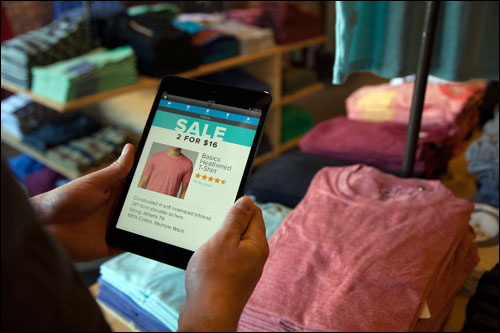Boston startup company ByteLight is marketing indoor-positioning technology that enables an LED light fixture to communicate a unique identifier to individuals with smartphones—not via Near Field Communication (NFC) RFID or Bluetooth Low Energy (BLE) beacon technology, but rather with tiny pulses in the light it emits. The technology, known as visual light communication, or light field communication (LFC), consists of software running on a silicon chip installed in an LED lamp. The software instructs the lamp to transmit its unique ID number in the form of a flicker (imperceptible to the human eye), as well as an application running on an individual’s mobile phone that decodes the light pulses perceived by the phone’s camera, in order to identify the phone’s location.
The result is a new method for capturing an individual’s attention via a cell phone, and for sharing details related to specific locations around that person. For example, the system could indicate where to find products displayed within a supermarket, or where a company’s booth at a conference is located in relation to a user’s phone.

ByteLight developed the solution as an alternative to the GPS technology used in mobile phones, which provides location data regarding the phone itself, but not indoors, where satellite transmission is typically blocked.
Three retailers are currently conducting tests of the LFC technology at their own laboratories, two of which plan to deploy the solution at their stores beginning in May 2014, according to Jordan Thayer, ByteLight’s director of product development. The solution consists of a lamp manufacturer’s own LFC-based chip, which can be built into LED lamps by that manufacturer in order to prompt a specific pulsing of light.
Retailers in China are already using the technology to enable a loyalty program in which users tap their phones against a ByteLight-provided LED device known as an LFC reader, to capture the ID encoded in the light emitted by the device, and thereby gain loyalty points at such stores as Yummie House, Happy Lemon, Carrefour, Besyo and Golden Phoenix. ByteLight partnered with software company Appconomy, which provides the mobile marketing platform on which the loyalty program’s data is managed.
The system is also in use at the Boston Museum of Science, where 40 LEDs utilizing the ByteLight technology were installed to better engage visitors in one exhibit hall, known as the Cahners ComputerPlace. A limited number of iPads are loaned to visitors, and as they move around the exhibit, the tablet’s built-in camera receives a light-pulsed ID number. An app running on the device forwards that data to the museum’s server—which, in turn, delivers information to the iPad regarding the exhibit at which that particular LED is located.
The technology does not require a battery, the company reports, since power is generated by the light itself. The location accuracy (within 3 feet) is greater than with BLE, which is typically 3 meters (9.8 feet) or more, Thayer reports. However, he notes, line of sight is required; if a phone’s camera is unable to detect the light, the transmission will not take place.
The app determines the phone’s location based on a triangulation of the light signals coming from around it. The more densely populated an area is with ByteLights, the greater that area’s granularity. The technology’s cost is reasonably low to install a chip that modulates light emissions, the firm reports—typically, less than a dollar per light. However, since the lamps cannot be retrofitted, the solution is thus most cost-effective if adopted at the same time that a company acquires all of its LED lamps. That, Thayer says, is what the retailers testing the technology intend to do during the coming year: replace the fluorescent lights at all of their stores with more efficient and longer-lasting LEDs. If they choose to adopt the ByteLight solution, the ByteLight devices (which currently amount to a chip) would be installed by the lamp manufacturer.
The company also plans to sell a license for its intellectual property (IP) to lamp companies, so that they can input the chips themselves for an LFC solution. According to Thayer, ByteLight is currently in discussions with several such manufacturers.
In practical use, the technology would alert a phone’s user to a particular product’s location. The system could detect the whereabouts of a participating consumer who has the retailer’s app downloaded and running on his or her phone. It could then send coupons specific to the store department in which that individual is browsing, and instruct the shopper regarding where the product is being displayed. For example, an LED light above the produce section could transmit data to a person’s phone, triggering the app to display such details as “bananas are half off,” as well as where the fruit is located.
Thayer says the technology would not cost much more than a dollar for each LED fixture in which it was installed. “Clearly, there’s a lot of excitement in this space,” Thayer states. Not only has ByteLight gained multiple patents for the technology, but lighting manufacturer Royal Philips recently announced that it is piloting the same type of solution with retailers. The company notes that it is still too early to discuss the details of its solution.


